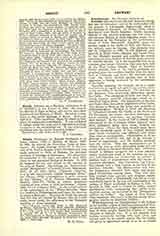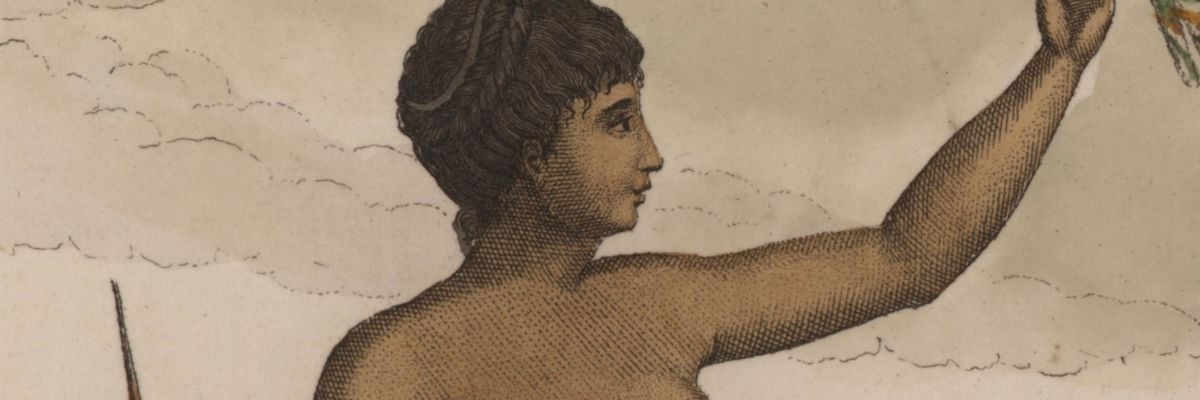

Arawaks (also ARUACAS), the first American aborigines met by Columbus—not to be confounded with the Aroacas or Arhouaques, linguistically allied to the Chibohas of Columbia—an Indian stock, widely distributed over South America. Tribes speaking dialects of the Arawak language are met with, in and between Indians of other linguistic stocks, from the sources of the Paraguay to the northwestern shores of Lake Maracaybo (Goajiros), from the eastern slopes of the Andes in Peru and Bolivia to the Atlantic coast in Guyana. The Arawaks were met by Columbus in 1492, on the Bahamas, and, later on, in Hayti, Cuba, Jamaica, and Puerto Rico. In the fifteenth century and possibly for several centuries previous, Indians of Arawak stock occupied the Greater Antilles. It is not impossible that up to a certain time before Columbus they may have held all the West Indian Islands. Then an intrusive Indian element, that of the Caribs, gradually encroached upon the southern Antilles from the mainland of Venezuela and drove the Arawaks northward. The latter showed decided fear of their aggressors, a feeling increased by the cannibalism of the Caribs.
Generally speaking, the Arawaks are in a condition between savagery and agriculture, and the status varies according to environment. The Arawaks on the Bahamas were practically defenseless against the Caribs. The aborigines of Cuba and Hayti, enjoying superior material advantages, stood on a somewhat higher plane. The inhabitants of Jamaica and Puerto Rico, immediate neighbors of the Caribs, were almost as fierce as the latter and probably as anthropophagous. Wedged in (after the discovery of Columbus) between the Caribs on the South and the Europeans, the former relentless destroyers, the latter startling innovators, the northern Arawaks were doomed. In the course of half a century they succumbed to the unwonted labor imposed upon them, epidemics doing their share towards extermination. Abuse has been heaped upon Spain for this inevitable result of first contact between races whose civilization was different, and whose ideas were so incompatible. Colonization in its beginnings on American soil had to go through a period of experiments, and the Indians naturally were the victims. Then the experimenters (as is always the case in newly discovered lands) did not at first belong to the most desirable class. Columbus himself (a brilliant navigator but a poor administrator) contributed much to the outcome by measures well intended, but impractical, on account of absolute lack of acquaintance with the nature of American aborigines. (See Christopher Columbus. Bartolome de las Casas.) The Church took a deep interest in the fate of the Antillean Arawaks. The Hieronymites and, later, the Dominicans defended their cause, and propagated Christianity among them. They also carefully studied their customs and religious beliefs. Fray Roman Pane, a Hieronymite, has left us a very remarkable report on the lore and ceremonials of the Indians of Hayti (published in Italian in 1571, in Spanish in 1749, and in French in 1864); shorter descriptions, from anonymous, but surely ecclesiastical, sources, are contained in the “Documentos ineditos de Indias”. The report of Fray Roman Pane antedates 1508, and it is the first purely ethnographic treatise on American Indians.
While lamenting the disappearance of the Indians of the Antilles, writers of the Columbian period have, for controversial effect, greatly exaggerated the numbers of these people; hence the number of victims charged to Spanish rule. It is not possible that Indians constantly warring with each other, and warred upon by an outside enemy like the Caribs, not given to agriculture except in as far as women worked the crops, without domestic animals, in an enervating climate, could have been nearly as numerous as, for instance, Las Casas asserts. The extermination of the Antillean Arawaks under Spanish rule has not yet been impartially written. It is no worse a page of history than many filled with English atrocities, or than those which tell how the North American aborigines have been disposed of in order to make room for the white man. The Spaniards did not, and could not, yet know the nature and possibilities of the Indian. They could not understand that a race physically well-endowed, but the men of which had no conception of work, could not be suddenly changed into hardy tillers of the soil and miners. And yet the Indian had to be made to labor, as the white population was entirely too small for developing the resources of the newfound lands. The European attributed the inaptitude of the Indian for physical toil to obstinacy, and only too often vented his impatience in acts of cruelty. The Crown made the utmost efforts to mitigate, and to protect the aborigine, but ere the period of experiments was over the latter had almost vanished. As already stated, the Arawaks, presumably, held the Lesser Antilles also, until, previous to the Columbian era, the Caribs expelled them, thus separating the northern branch from the main stock on the southern continent. Of the latter it has been surmised that their original homes were on the eastern slope of the Andes, where the Campas (Chunchos or Antis) represent the Arawak element, together with the Shipibos, Piros, Conibos, and other tribes of the extensive Pano group. A Spanish officer, Pedro de Candia, first discovered them in 1538. The earliest attempts at Christianization are due to the Jesuits. They made, previous to 1602, six distinct efforts to convert the Chunchos, from the side of Huanuco in Peru, and from northern Bolivia, but all these attempts were failures. There are also traces that a Jesuit had penetrated those regions, in 1581, more as an explorer than as a missionary. Notwithstanding the ill-success accompanying the first efforts, the Jesuits persevered, and founded missions among the Moxos, one of the most southerly branches of the Arawaks, and also among the Baures. Those missions were, of course, abandoned after 1767. During the past century the Franciscans have taken up the field of which the Jesuits were deprived, especially the missions among the Pano or Shipibo tribes of the Beni region in Bolivia. The late Father Rafael Sanz was one of the first to devote himself to the difficult and dangerous task, and he was ably followed by Father Nicolas Armentia, who is now Bishop of La Paz. The latter has also done very good work in the field of linguistics. Missions among the Goajiros in Columbia, however, had but little success. Of late the tribe has become more approachable. The Arawaks of the upper Amazonian region were probably met by Alonzo Mercadillo, in 1537, and may have been seen by Orellana in 1538-39. The Arawak tribes occupying almost exclusively the southern banks of the Amazon, they were reached by the missionaries later than the tribes on the north bank. Franciscans accompanied Juan de Salinas Loyola (a relative of St. Ignatius) in 1564. But the results of these expeditions were not permanent.
In the heart of the Andean region the Friars of the Order of Our Lady of Mercy (Mercedarios) were the first to establish permanent missions. Fray Francisco Ponce de Leon, “Commander of the convent of the city of Jaen de Bracarnoros”, and Diego Vaca de Vega, Governor of Jaen, organized in 1619 an expedition down the Maranon to the Maynas. In 1619 they founded the Mission of San Francisco Borja, which still exists as a settlement. The first baptisms of Indians took place March 22, 1620. The year following, Father Ponce made an expedition lower down the Amazon, beyond the mouth of the Rio Huallaga where he came in contact with the Arawak tribes, to whom he preached, and some of whom he baptized. The Franciscans entered from the direction of Jauja or Tarma, towards Chanchamayo, in 1631 and 1635. The first foundation was at Quimiri, where a chapel was built. Two years later the founders, Fathers Gerbnimo Ximenez and Cristoval Larios, died at the hands of the Campas on the Perene River. Work was not interrupted, however, and three years later (1640) there were established about the salt-hill of Vitoc seven chapels, each with a settlement of Indian converts. But in 1742 the appearance of Juan Santos Atahualpa occasioned an almost general uprising of the aborigines. Until then the missions had progressed remarkably. Some of the most savage tribes, like the Conibos, became at least partly reduced to obedience, and led a more sedate, orderly life. In 1725 the College of Ocopa was founded. All these gains (except the College of Ocopa and the regions around Tarma and Cajamarquilla) were lost until, after 1751, Franciscan missionaries again began to enter the lost territory, and even added new conquests among the fiercest Arawaks (Cashibos) on the Ucayali. Conversions in these regions have cost many martyrs, not less than sixty-four ecclesiastics having perished at the hands of Indians of Arawak stock in the years between 1637 and 1766. Missionary work among the Arawaks of Guyana and on the banks of the Orinoco, began, in a systematic manner, in the second half of the seventeenth century, and was carried on from the Spanish side among the Maypures of the Orinoco, from the French side along the coast and the Essequibo River. Wars between France, England, and Holland, the indifferent, systemless ways of French colonization, but chiefly the constant incursions of the Caribs, interrupted or at least greatly obstructed the progress of missions. Ethnologically the Arawaks vary in condition. Those of Guyana seem to be partly sedentary. They call themselves Lokonono. They are well built. Descent among them is in the female line, and they are polygamous. They are land-tillers and hunters. Their houses are sheds, open on the sides, and their weapons bows, arrows, and wooden clubs. Their religious ideas are, locally varied, those of all. Indians, animism or fetishism, with an army of shamans, or medicine-men, to uphold it. Of the Campas and the tribes comprised within the Pano group, about the same may be stated, with the difference that several of the tribes composing it are fierce cannibals (Cashibos and Conibos). It must be observed, however, that cannibalism is, under certain conditions, practiced by all the forest tribes of South America, as well as by the Aymara, of Bolivia. It is mostly a ceremonial practice and, at the bottom, closely related to the custom of scalping.
AD. F. BANDELIER


